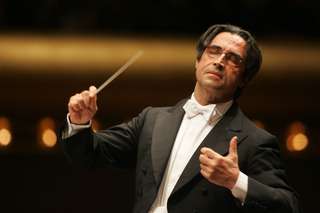|
Back
The Glory That Was Muti’s New York
Avery Fisher Hall
04/22/2009 - & April 23, 24, 25, 2009
Giuseppe Verdi: Overture from Giovanna d’Arco (Joan of Arc) – Ballet of the Four Seasons from I vespri siciliani (Sicilian Vespers)
Giacomo Puccini: Preludio sinfonico
Ottorino Respighi: Pini di Roma (The Pines of Rome)
New York Philharmonic Orchestra, Riccardo Muti (Conductor) 
Riccardo Muti (© Chris Lee)
Philistine! Groundling! Insensitive Babbitt!!!
How else could one classify a supposedly knowledgeable music critic who sits through a week of the most profound artists performing late Beethoven, a dramatization of a Bach Passion, Uchida playing Ravel, Carter and Holliger approving of their own music,–and finally letting tears roll down his cheek for a….a piece by Respighi, for heaven’s sake??
Well, the jig is up. I won’t even dignify the culprit with the Latin Mea culpa. I was the one who sobbed like a baby at the finish to Pines of Rome. And while certain extenuating circumstances allowed this, I say it without pride at all.
One obvious excuse is that Riccardo Muti was the conductor. The Naples-born luminary is one of the few conductors who can turn the New York Philharmonic from excellent to extraordinary. And while Mr. Muti is one of the most eclectic of conductors, his ties to Italy are both musically and psychologically special.
So when attending the opening night of a week where mainstream opera composers were “going orchestral”, it boded a very special experience.
That it was, if for no other reason than one saw Verdi’s opera music in an entirely new light. We attend Verdi for the drama, the voices, the arias and the theatre. Mr. Muti, though, took music from a rarely heard early opera and the usually omitted ballet music of a middle period opera, and we had to listen with new ears.
Joan of Arc is actually a passable opera, with a silly plot. But Verdi’s fifth opera has a really dramatic overture, and Mr. Muti started the evening with a magical opening of eerie atmospheres, heading into the pastoral moments of Joan herself. In the opera house, we see it as prelude. Here, Mr. Muti made it actually aggressively musically inspired.
One cannot say that for the four movements of the Sicilian Vespers ballet. The 20-odd minutes of ballet in the Governor’s palace has nothing to do with the opera, and standing by itself, as here, is only of passing interest. Yet in the four seasons, we had some wonderful solo playing from the winds. The almost iconic Stanley Drucker played a long virtuosic clarinet solo for the “Spring” session, while first chair oboist Liang Wang took on the heat wave of summer single-handedly! (Okay, double-handedly.). While most of the movements were relatively uninspired, one must realize that this was for dancers, and also—this the surprising part—that Verdi’s sense of tunes, if not arias, never deserted him.
But that first half was most notable for Mr. Muti himself. He is a wonderfully graceful figure on any podium, but here, he was literally, performing ballet steps and gestures to make this prosaic music almost poetic.
The second half started with another rarity, Puccini’s early Symphonic Prelude. We know Puccini for operas, of course. And a visit to Lucca, where half the churches were inhabited by his organist forebears, we think of his church music from Tosca. This short orchestral piece is pretty enough, was played with silken strings by the Phil, and was obviously a bit of ephemerae.
The last work, though, was the one which turned this writer into a quiet bawler. Let’s face it, Respighi, a pupil of Rimsky-Korsakov, a lover of medieval and pre-Baroque music and a genius in his own right, had some tremendous orchestral portraits. But Pines of Rome is the most stupendous of all. The blustering first movement, with its happy horn calls, its out-of-tune trumpets and the shimmering orchestral sounds is a great opening, and the following moody “catacomb” pines takes on those Gregorian-like hymns which Respighi loved so much.
The third group has the recorded nightingale sounds and other reflections of nature. But the ending Pines of the Appian Way not only is mighty in itself, but brings forth images of Imperial armies, victories, and the blaring buccina trumpets of the Cesarean armies.
No good conductor will hesitate to pull out all the stops for this vast crescendo, but Mr. Muti, having conducted the first three sections with adoration, love and atmosphere, now gave us the great surprise. As chord piled upon chord, as the orchestral consorts vied with each other to create their own massive blocks of majesty, Mr. Muti turned halfway around to the auditorium.
So did we. For on both sides of the second balcony was a brass choir, and each brass choir vied with each other and the orchestra to make this ending as august, Augustean, aimperatoriouss, majestic and voluminous as possible.
And that is when this Philistine felt the tears of joy well into the eyes and down the cheeks. Admitting that some find Respighi vulgar, others find it empty, the rest of us want to hear a hint of the glory that was Rome. Riccardo Muti gave us glory, pageant, and an especially spatial victory.
Harry Rolnick
|